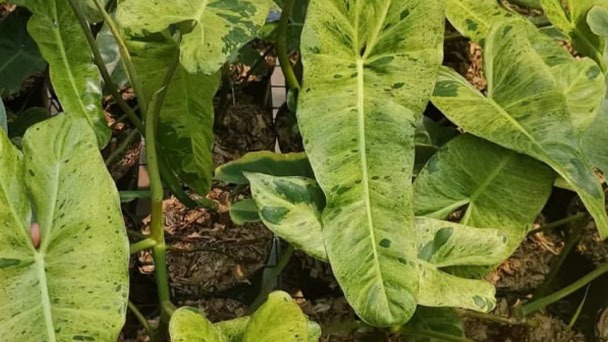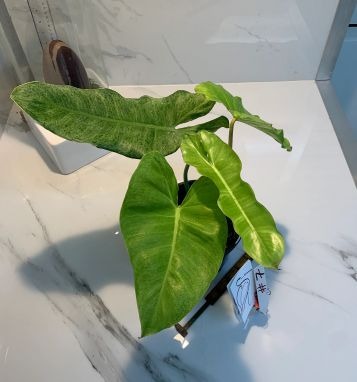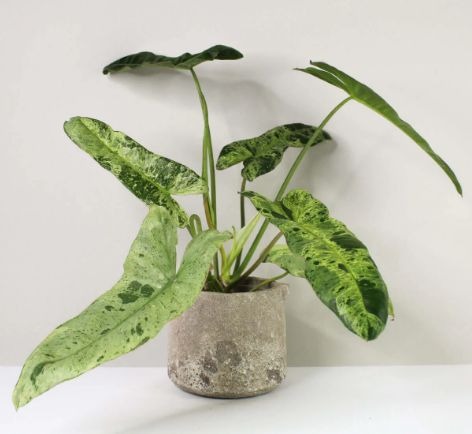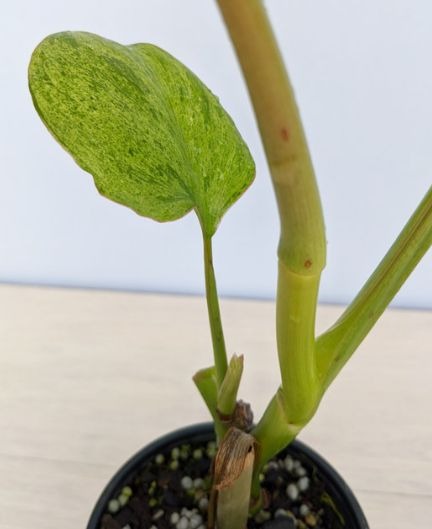Philodendron Paraiso Verde Care & Ultimate Growing Guide
Written by Ivy
Jan 10 2023

Care for Philodendron Paraiso Verde is simpler than you might think. Even though it needs special care, taking care of it is not difficult at all, and this care guide can assist you. It might be difficult to locate The Philodendron Paraiso. But if you do manage to find one, it will be well worth it.
Philodendron Paraiso Verde Overview
| Origin | Tropical America and the Caribbean |
| Family | Arecaceae |
| Common name | Green Paradise |
| Type | Evergreen Philodendron |
| Maximum growth | To 15 inches |
| Watering | Likes to be kept slightly moist |
| Light requirements | Bright light but not direct sunlight |
| Humidity | Quite high 55 to 75% |
| Soil | 60 % potting soil 40% perlite |
| Feeding | Once a month during spring and summer |
| Season | Slows down during the cooler months |
| Temperature | 55 to 90°F (12° TO 32°C) |
| Pests | Mealybug, spider mite, aphids and scale insects |
| Diseases | Brown leaf tips, blight, leaf spots, leaf curl |
| Propagation | Stem cutting in soil or water |
| Pruning | Minor tidying up occasionally |
| Re-potting | When roots totally fill the pot |
| Toxicity | Quite High |
| USDA Hardiness | Outdoor 9b to 10 |
What Does a Philodendron Paraiso Verde Look Like
This particular plant is cultivated primarily for its exquisite foliage. The seven to ten inch long leaves are frequently marbled in various shades of green, giving them a striking appearance.
The amount of light influences the color of the leaves. These plants are climbers with fairly slender stems in their natural habitat, so as yours grows, you might need to give it some support. Although they can get quite big in the wild, they usually don't grow much taller than fifteen to twenty inches inside the home.
Philodendron Paraiso Verde Care

Light
The Philodendron Paraiso Verde requires plenty of light, but not exposure to the sun.
The distinctive variegation of Paraiso Verde will persist in areas with a lot of indirect sunlight.
You might discover that Paraiso Verde benefits from a very small amount of direct morning sunlight, particularly for its variegation.
However, bear in mind that only morning sunlight should be present.
It's never a good idea to spend all day in the sun.
The variegation pattern on your Paraiso Verde might even be ruined by full sun, which also runs the risk of burning the leaves.
With that said, a bright room with lots of natural light is a great place for this Philodendron.
Make sure you have a sheer curtain to diffuse the light your plant will receive if you place it close to a window.
If you decide to put your Paraiso Verde outside, put it in a shaded area or under a shade cloth.
Soil
Given that Paraiso Verde is a member of the Philodendron family, it's critical to provide it with the kind of chunky, well-draining soil that it would find in its native habitat.
The ideal growing medium for Paraiso Verde is aroid potting soil.
You can use our recipe for an excellent aroid soil mix for your Paraiso Verde and any other philodendrons or aroids you may have. Because it is chunky, your plant will benefit in two ways.
The roots of your Philodendron Paraiso Verde can first grab onto the loose soil.
Second, the soil's texture allows water to drain through, which will aid in preventing root rot.
Making your own potting soil is another option for your Paraiso Verde.
Watering
Care for Philodendron Paraiso Verde must include frequent watering.
Generally, it can be intimidating to start watering any aroid or philodendron.
However, it's best to wait until the soil has completely dried out before watering your Paraiso Verde again.
Overwatering plants can lead to problems for even seasoned plant parents.
Because of this, it is best to be safe and let the soil in your Paraiso Verde plant dry out in between waterings. A moisture meter can be used to measure the moisture in soil.
As an alternative, you can check for moisture by sticking your finger into the ground up to your second knuckle. Wait to water if you even detect a hint of moisture.
Root rot, which is bad for your plant's health, could result from over-watering your Paraiso Verde.
The best course of action is to take precautions to prevent root rot by giving the plant well-draining soil and a pot with lots of drainage holes.
Captured rainwater is the ideal kind of water to use for your Paraiso Verde. Filtered water is a close second best if you don't have a rain barrel. However, regular tap water will also work just fine.
Humidity
Because the Philodendron Paraiso Verde is native to tropical forests, it enjoys high humidity levels.
Aim for 65% or more humidity in your Paraiso Verde. A Philodendron will be extremely content if you reside in a humid area.
There are ways to give your Paraiso Verde enough humidity if you don't live in a humid area so it can stay happy and healthy.
Utilizing an indoor humidifier is one method of boosting humidity for your plant. It's crucial to use an indoor humidifier correctly. To stop mold from spreading through the air, use distilled water and regularly clean your humidifier.
Misting your plant's leaves with distilled water is another way to increase humidity. However, be cautious when using this technique as frequently wet leaves can cause a fungal infection in your plant.
You can also raise the humidity level around your Philodendron by setting it on top of a pebble tray with water in it. The air around your plant will become more humid as the water in the tray evaporatively rises.
Finally, to increase the humidity around them, group additional plants that enjoy humidity around a bowl of water. By grouping them together, you can effectively "trap" the humid air that is present around the leaves.
Temperature
Since Philodendron Paraiso Verde is a tropical plant, it prefers temperatures between 65 and 85 degrees Fahrenheit (17 and 29 degrees Celsius).
Helping your Paraiso Verde avoid frost or being exposed to extreme temperature changes is crucial when it comes to temperature.
If you keep your Paraiso Verde outside, bring it inside when the outside temperature falls below 65°F (17°C).
If you keep your Paraiso Verde indoors, keep it away from drafts created by heaters, air conditioners, furnaces, and open windows.
Fertilizing
Only a medium-level feeder, the Philodendron paraiso verde plant. During the growing season from spring until late summer, it requires fertilization every four to six weeks. Fertilize after two months during the fall and winter.
- Commercial Fertilizers
Utilize a commercially available, balanced fertilizer with an NPK value of 20 20 20 or 10 10 10. All the essential nutrients your plant needs are present in equal amounts in these fertilizers.
Never use fertilizer at a concentration greater than half of what is suggested on the label. Co-ordinate fertilizing and watering. This prevents fertilizer burns from occurring on your plant.
- Organic Fertilizers
Obviously, organic fertilizers are not as nutrient-dense as those made commercially, but they are still very beneficial. We add eggshells, banana peels, and ground coffee beans to the soil for the Philodendron paraiso verde plant.
It is the most nourishing organic mixture for your plant. Similar to this, you can improve your soil by adding compost when you repot your plants.
Pruning
These plants typically don't spread out too much, in contrast to some Philodendrons. The majority of the pruning you'll need to do will just involve tidying up any damaged leaves.
Consider it more like grooming than pruning. The plant will benefit from having some sort of support because the stems of the plants are relatively thin in comparison to the size of the leaves. The plant can root as it climbs using a moss stick, just like it would in the wild.
Propagating Philodendron Paraiso Verde
As you may have already found out, these plants are expensive and still quite uncommon for domestic home growers. The good news is that you can grow your collection at no additional cost by yourself propagating them very simply.
They can be started off in water or a soil medium using simple stem cuttings, and they are grown from these.
- You must make your cut just beneath a leaf node. The best tool for this job, in my opinion, is a clean, sharp knife.
- Retain no more than one or two leaves after taking the cutting. Usually, I just have one. It should be planted in the same potting mixture that you used to grow the parent plant, and it should be placed in an area with direct but bright light.
- Roots will begin to emerge from the plant in two weeks. At this point, don't do anything more, but do make sure the soil is consistently moist.
- Following that, the plant's top may begin to grow more quickly.
- Before the plant needs to be potted up into a larger pot, it will most likely be at least another two to three weeks.
The plant's growth will probably start out slowly while it establishes itself, but it will then pick up speed.
You can simply place your cutting into a glass container filled with water as an alternative to planting it in soil. Reducing the leaf to plant ratio will prevent the new roots from having to work too hard to support an unrealistic leaf mass.
Once you can see that the plant has a lot of roots, you can remove it from the water and plant it in a small pot. Change the water occasionally while you wait for the roots to enlarge to the point where they can be potted.
Repot Using Stem Cuttings
Philodendron Paraiso Verde stem cuttings can be used, and they can either be planted directly in the ground or first submerged in water before being planted in the soil. Continue reading for a more thorough explanation.
For taking stem cuttings for propagation, use a clean, disinfected gardening knife. This ensures the health and infection-free survival of your cuttings.
A 3–4 inch stem cutting should be used. Additionally, it ought to contain three to four leaf nodes. Remove all but the last leaf from it. The cutting should then be dried by being placed on a piece of paper towel. On both ends of the cutting, add rooting hormone.
Propagating in Water
Fill a transparent container, such as a bucket, with water. Set the Philodendron Paraiso Verde stem cutting inside it upright. To keep it upright, you might need to use a support of some sort.
Put this jar in a room with a lot of indirect light that is warm and bright. Up until new growths start to emerge from the leaf nodes, keep weekly water changes in place.
When your baby plant's baby roots begin to emerge, it's time to begin acclimating it to the dark, oxygen-starved conditions of the soil. Every day, add one tablespoon of soil to this water until the soil has eventually completely replaced the water.
The plant will have grown roots by this time that are long enough to be moved into a real pot filled with soil.
Propagating in Soil
It is fairly simple to propagate Philodendron Paraiso Verde in soil. The proper potting medium should be placed inside a small pot. Insert the cutting upside-down in a tiny hole that has been made in the soil's center.
The one leaf in the cutting that is still present should be elevated above the soil. Put this pot in a warm, humid location. For the first few days, keep it moist.
The appearance of shoots, a sign that your propagation was successful, will occur in three to four weeks.
Other Important Tips for Philodendron Paraiso Verde Care

Moss Pole
Paraiso Verde enjoys climbing a lot.
In their native tropical rainforest habitat, they would typically climb up tree trucks.
Giving your Paraiso Verde a moss pole to climb on and cling to is crucial for this reason.
If you want to make your own DIY moss pole, we wrote a comprehensive article.
The first step is to roll up some pre-moistened sphagnum moss inside PVC-coated wire mesh.
The mesh should be rolled up to resemble a pole, and it should then be tied off with plastic-coated wire twists.
When it comes time to re-pot your plant, it is best to add a moss pole.
You can repot your plant with your new moss pole and expand the pot by a few inches at the same time.
Place some moistened sphagnum moss around the aerial roots of your Paraiso Verde plant and tuck it into your moss pole to encourage the growth of the roots.
Pests
Inadequate living conditions can lead to pest issues with Philodendron Paraiso Verde.
Scale, mealy bugs, spider mites, and aphids are a few examples of typical pest issues.
At every watering, don't forget to check and inspect your Paraiso Verde. By doing this, you can keep track of any potential pest issues.
If you come across a pest issue, isolate your Philodendron and take the appropriate steps to treat it with commercial or natural insecticides.
If you are dealing with a spider mite infestation, this article can be of assistance.
Toxicity
All philodendrons have calcium oxalate crystals that, if consumed by people or animals, can be poisonous.
Avoid letting children or family pets near your plants.
Re-potting
Your Paraiso Verde may only require repotting every year or every two years.
When the plant's roots start to extend past the drainage holes in the pot, it's time to repot.
Repotting is best done in the spring.
Increase the pot's diameter by 2 inches, and don't forget to use your aroid soil mix that is chunky and well-draining.
Common Problems and How to Fix Them
Pests and How to Combat Them
An invisible waxy cuticle that covers the leaves serves as the Philodendron Paraiso Verde's primary barrier against pests. The cuticle of your plant will be thicker and more capable of self-defense the healthier it is.
Since almost all predatory pests are sap-sucking insects, maintaining a healthy plant will reduce your need to deal with them.
They must be able to access the sap by penetrating the protective cuticle with their tiny mouthparts. If they are unable to do that quickly, they move on to another, more vulnerable plant, hopefully one that is located in your neighbor's home.
A regular close examination of the leaves and leaf joints is essential to fending off attacks. It is much simpler to prevent an infestation if just a few pests are discovered early on rather than after the creatures have already established themselves. A magnifying glass is a helpful tool to have on hand when performing an inspection.
Aphids
Aphids are a pesky insect that feeds on plant sap and reproduces incredibly quickly. In areas with soft leaf parts, they frequently favor new growth.
They quickly begin reproducing once they have established themselves. According to estimates, if all of an aphid's offspring were to live for a year, their combined weight would be sufficient to knock the planet off its axis.
We can rest easy at night knowing that these tiny creatures are extremely fragile and have no chance of abruptly launching themselves into another universe. Anti-insect soaps or Neem oil applied to a soft cloth can be used to remove them from the leaf.
Mealybugs
Mealy bugs might be to blame if you see tiny white blobs on the leaves of your plant. These pests are tiny insects that resemble dustings of flour or tiny balls of cotton wool.
They enjoy skulking in leaf joints and obtaining the sap of the prey plants from there. You might be able to remove them with a water jet, Neem oil, or insecticidal soap.
Scale Insects
Due to the way they appear on the surface of the leaf or stem as tiny light brown scabs, these insects are sometimes able to evade detection. They are also sucking away at the sap and weakening their host plant from beneath their hard little shells.
If detected early, Philodendron Paraiso Verde can frequently be eliminated by simply being scratched off with the back of a knife or your fingernail. Use earbuds to wipe them down in greater quantities after dipping them in Neem oil.
Spider Mites
To the naked eye, these microscopic mites are essentially invisible. A fine web near the base of the leaf or leaf portions that have turned brown and desiccated where they have sucked out all of the sap are frequently the first signs of their presence.
These creatures deposit their eggs on the underside of leaves. Placing the plant in a sink and carefully rinsing off their webs with warm water are good ways to begin defending against an attack. Using Neem oil to wipe down afterward should keep them at bay.
Because they prefer dry environments, spider mite are not very prevalent in Philodendron Paraiso Verde.
Since we already know that these plants prefer high humidity, the presence of spider mites may serve as a reminder to check the humidity levels. Since Philodendron Paraiso Verde is an expensive plant, it is worthwhile to give them a little extra care.
Those leaves will stay in stunning shape, which is their signature, with a weekly wipe down with neem oil, and this should keep pests away from ever becoming a problem for you.
To prevent pests from spreading to the other plants in your collection, isolate the infected plant if you do encounter a pest issue.

Diseases and How to Combat Them
The majority of diseases that affect Philodendron paraiso verde are probably related to improper watering techniques.
Brown Leaf Tips
This issue is frequently the first sign that your plant needs more water than it is receiving. The brown tips turn dry, crisp, and flaky. Analyze your watering schedule.
The tips won't grow back, but if you get the moisture level just right, the issue shouldn't worsen. Bacteria or fungus may be to blame for the black or brown spots on the leaves.
The reason for this is frequently wet weather. When watering your plant, don't water the leaves; only the base of the plant.
Aim for good airflow, and stay away from overwatering. A horticultural fungicide, which is readily available at nurseries and plant suppliers, can be used to solve the issue.
Leaves Curling
Low humidity, underwatering, or excessive fertilization can all contribute to this one. Be sure to only fertilize with a balanced fertilizer during the spring through mid-summer growing season. The recommended frequency is once a month.
Leaves Floppy and Wilting
Lack of water or humidity may be the culprits behind this. By repeating the infamous finger test, it will be simple to identify the issue. Immediately apply water if the soil is too dry. Increase the humidity if the soil is wet.
Brown Soggy Marks on Leaves
Your plant may be experiencing root rot if you start to see brown watery patches on the leaves or rotting on the stems.
This is a very serious situation that needs to be handled right away. Overabundance of water in the root ball is almost always the cause.
- The plant should be tapped out of its pot and placed on a piece of paper out of the sun as soon as possible. Dry it off, and then carefully inspect the root ball. Any root material that is brown or drenched in moisture should be removed because it only serves to harbor fungi.
- Repot the plant next, but don't water it for a few days. One can only hope that the plant will begin to show signs of reviving.
- After that, keep the soil moist but not soggy. After watering, make sure to drain all extra water.
Conclusion
You absolutely must try to find Philodendron Paraiso Verde for your plant collection because it is a hard to find but rewarding plant.
If you are one of the fortunate people to own this philodendron, use this care guide to keep it healthy so you can enjoy it for years to come.
Latest Updated
- Benefits of Bugleweed - 7 Science-backed Health Benefits
- Bugleweed Dangers & Side Effects - Is It Poisonous?
- How to Plant Evergreen Trees - What You Should Know
- When to Plant Evergreens - Grow Guide for Evergreen Trees
- 12 Wonderful Evergreen Shrubs for Your Garden
- 12 Popular Evergreen Plants with Pictures for Beginners
- When And How To Prune A Lilac Bush Like a Pro
- How to Grow & Care for Lilac Vine (Hardenbergia Violacea)
- Japanese Lilac Tree (Syringa Reticulata) Care & Propagation Guide
- Shumard Oak Pros and Cons - What to Know
Popular Articles
- Winter maintenance of Antirrhinum Majus
- How to Grow Terminalia Mantaly Tree
- How to Grow and Care for Crossostephium Chinense
- How to grow Antirrhinum Majus in spring
- Peristeria Elata (Dove Orchid) Profile: Info & Care Guide
- Underwatered Snake Plant (Sansevieria Trifasciata) - Signs And How To Fix
- How to Care for Brazilian Jasmine Plant (Mandevilla Sanderi)
- How to Grow & Care for Graptopetalum Purple Delight in Summer
- Rosa Chinensis (China Rose): Plant Growing & Care Tips
- How to Care for Baby Sun Rose (Aptenia Cordifolia)